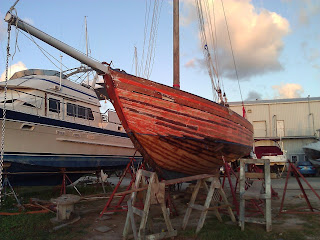Ok so this week has been full of long hard days of work on the hull of Good Expectation. The week started with Mr Cochrane finishing the work of replacing rotten and damaged planking on both the hull, deck and doghouse sections.
Meanwhile Herbert and I focussed upon cleaning out the seams of the hull to ensure that when it came time to caulk and seal them that there would be a tough strong bonding surface to ensure many years of healthy planking.
The Topsides, which is the part of the hull above the water on the side of the boat were taken to bare wood and the seams thoroughly excavated by hand and electric grinder leaving a solid platform on which to build the new layers of protection for the wood.
A different section of the topsides, this section is original "purpleheart" a type of wood commonly sourced from Guyana in South America, its very hard, strong and longlasting, dense like mahogony and beautiful, but very tough going to sand!
So once the seams have been cleaned out its time to caulk them. This involves banging cotton string into them, the string is called caulking twine and its a long and labourious process which includes rolling the twine on your thigh like you're making a Cuban Cigar! This specialised job was undertaken this week by Manny a new member on the team. He is very experienced in this process. By the end of the week Cochrane and Bowtie had joined in the caulking and the side they worked on was a constant mix of banging and heated debate on many topics, but mostly about the state of local politics and understanding the fairer sex!
Caulking Mallet and Twine
Once the seams have been caulked its time to fill them. Above the waterline this is done with Putty, mixed with linseed oil and redlead powder. Its a surprisingly tiring job and tough on the fingers as the constant kneading of the putty gives you cramp! The putty is similar to that used to bed window panes. Below Herbert prepares the putty for filling the topsides seams...
Below the waterline we use a different material - West System epoxy, which hardens like cement but stronger. Not only does it make the wood totally impervious to water, it also forms an impenetrable barrier to the dreaded worms! Not as obvious as the orange putty, below image shows the West System sanded smooth and filling the seams. Next job here is to paint a film of West System epoxy other the entire bottom to make a complete impervious barrier. This is a costly process but well worth the investment for the long term benefit of the boat.
Here you can see the putty clearly filling the seams. Next it needs to be sanded and then a coat of the primer can be applied, once this stage is reached the boat will start to take shape very quickly with the back breaking works all behind us...
Earlier in the week we were treated to an amazing lightning display out to the West over Montserrat. I managed to capture a couple of shots, but as usual they do not do the display justice!











No comments:
Post a Comment